Note: Welcome to my Tip of the Week. If there is a tip I found, and I tested it, and it worked, I will share it. If you are just stopping by for the tip and not the story, scroll to the graphic at the end of the post.
It’s November and there I am, standing in my kitchen. Staring at my sauté pan. Wondering if exchanging diamond earrings for a pan was a good idea. I am unusually quiet. I am waiting for the pan to invite me into its life. Tell me its secrets. Make me the master chef I never wanted to be.
My beau is standing behind me. Respecting my quiet meeting with my pan.
When he proposed to me, he told me I was unlike any woman he had ever met. I think he is finding out how true that statement really is in this moment.
But, it’s just a pan. So the silence wanes on and on. I keep hearing the words from the sales lady, “Stainless steel pans are pretty hard to master. One day I am able to cook a perfect chicken breast in it. The next day, food is sticking and burnt.”
But it was just so pretty. All shiny. Just waiting to be used.
I think that trial and error might be best but this time, unlike others, I am not patient enough for that. I do some research online and find some tips.
If your food is sticking to your pan, it might be:
- too hot
- too cold
No one told me I was going to be reading a version of Goldilocks when I went on my search. Then again, Stout is standing in the kitchen with me and he looks just like a little bear.

Back to the pan. So, I am gathering it needs to be just right? And it hits me, I am Goldilocks and this pan is my porridge. Here’s to a fairytale ending.
The thing with stainless steel pans is, there are so many. Big, small, different metals…on and on. So there is no cookie cutter, “Heat for three minutes, no more and no less and you’re ready to rock and roll.”
It needs to be tested. You need to take the temperature of your pan. And here’s how.
TAKING THE TEMPERATURE OF YOUR PAN
First, I start with a little pep talk that goes something like this, “Listen, you beautiful shiny pot, I bought you and I am going to use you. And you are going to cooperate. And I am going to make lots of food in you and I will give you some of the credit. We’re a team ok? Let’s do this.”
And thus the experiment begins.
Turn your stove onto medium heat. If you are using stainless steel you definitely want medium heat or maybe a little less than medium high. Stainless steel does an excellent job at maintaining heat and even cooking. It’s what they’re known for. So if you crank your stove to high, your pan will get really hot really fast and it will be hard to bring it back down to a good cooking temperature.
As your pan is heating, you will be able to check it’s temperature every 30 seconds with a droplet of water. An 1/8 to be exact. Do not try to do this test with 1/4 teaspoon because that is too much water and this test will not work.
The first time you drop the water in, you might see this:
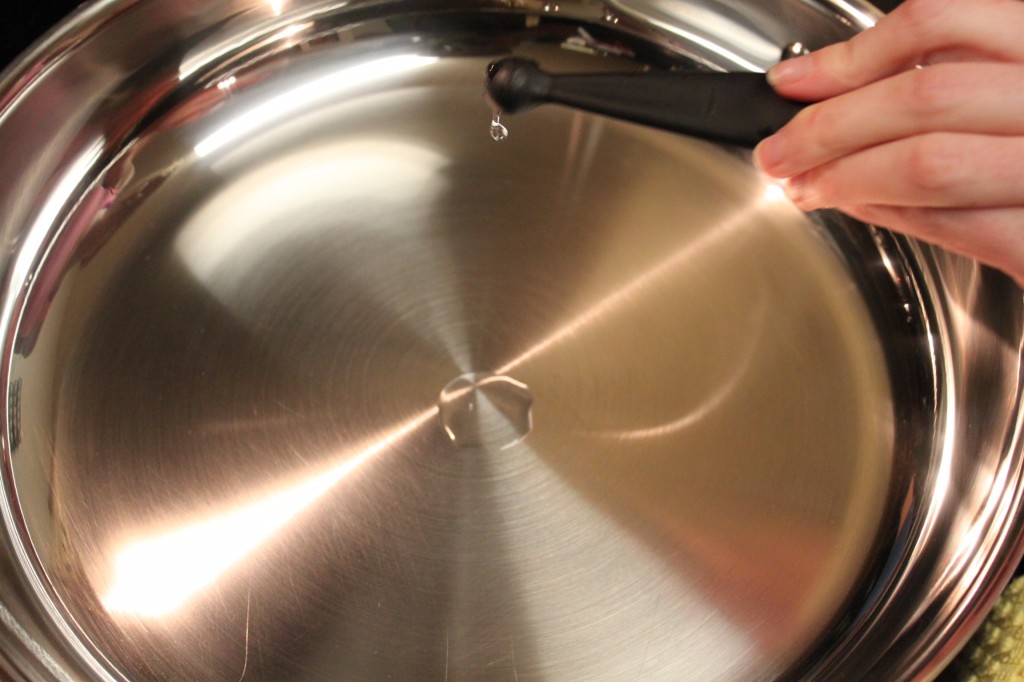
If the water does not react at all, that means the pan is still too cold and you need to let it warm up a little bit.
Wait about 30 to 45 seconds and try the test again.
If you drop the water in and it bubbles and steams like the below picture, it is still too cold.

Again, wait another 30 to 45 seconds. Take a step back. Take a swig of water. Do some yoga poses to maintain peace.
You will probably experience this bubble effect one or two more times (like I did). This is no time to give up.
Jump a few times in the air like you’re in a boxing ring. That always helps. Take a second to mark off “exercise” from your to-do list.
Ask for a few shoulder rubs from your man or whoever happens to be nearby and step back into the ring.
Next, you will probably see this:

These round bubbles are what you are looking for….well, the shape is what you are looking for. But you need to see one, large ball of water glide along the pan to know your pan is ready.
Time for a little lesson.
Stainless steel pans have pores in them and when heated these pores open and close during the heating process. If your pan is not heated properly and you put your chicken (or what have you) in the pan, the opening and closing pores will latch onto your food, causing it to stick when you go to flip it.
When the pan is at the right temperature, the pores are no longer opening and closing. This is why the water test is perfect. When water hits a pan and forms one perfect ball that glides across the pan, the pores are stable. Your pan is heated.
This is the one perfect ball of water you are looking for:
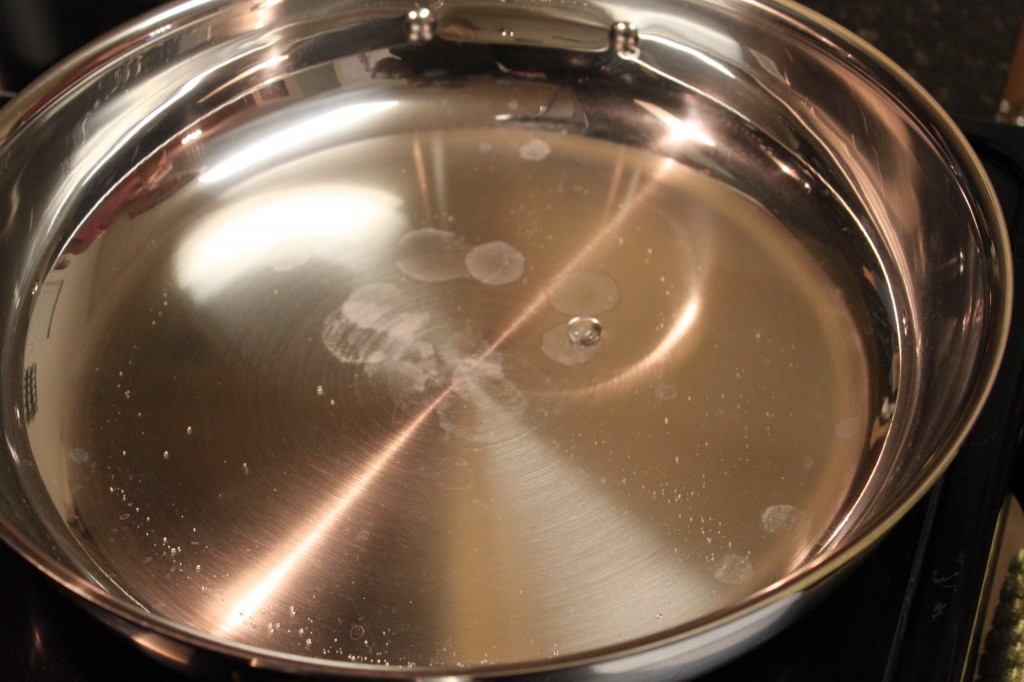
Look near the middle to the right-hand side and you will see the ball I am mentioning.
Here is another close-up:
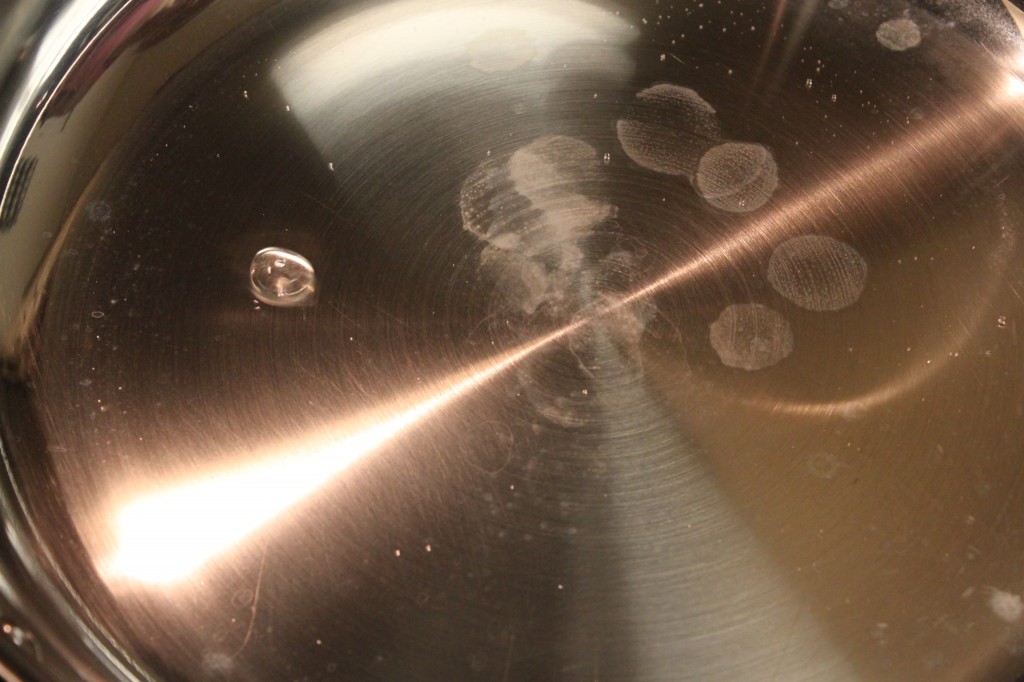
Obviously at this point I want to do an elaborate, choreographed dance in celebration of properly heating my pan BUT, THERE IS NO TIME FOR THAT.
Maintain composure. Push those feelings of joy to the side, temporarily. (I am not all about suppressing emotions, as my beau can attest to.)
Seeing as the pan is at the EXACT right temperature, you have to act quickly because the pan is still on the heat source and still climbing in temperature. Have your oil by your pan and add it quickly. It is also good to have your food ready to be put in your pan.
When you add anything to a pan, it lowers the temperature. Adding the oil will result in a slight decrease in temperature but only for a few seconds. You will know your oil is properly heated when you see the very first whisp of smoke. Or, if you move the oil around and you see legs form (the kind of legs you see when you swirl a glass of wine).
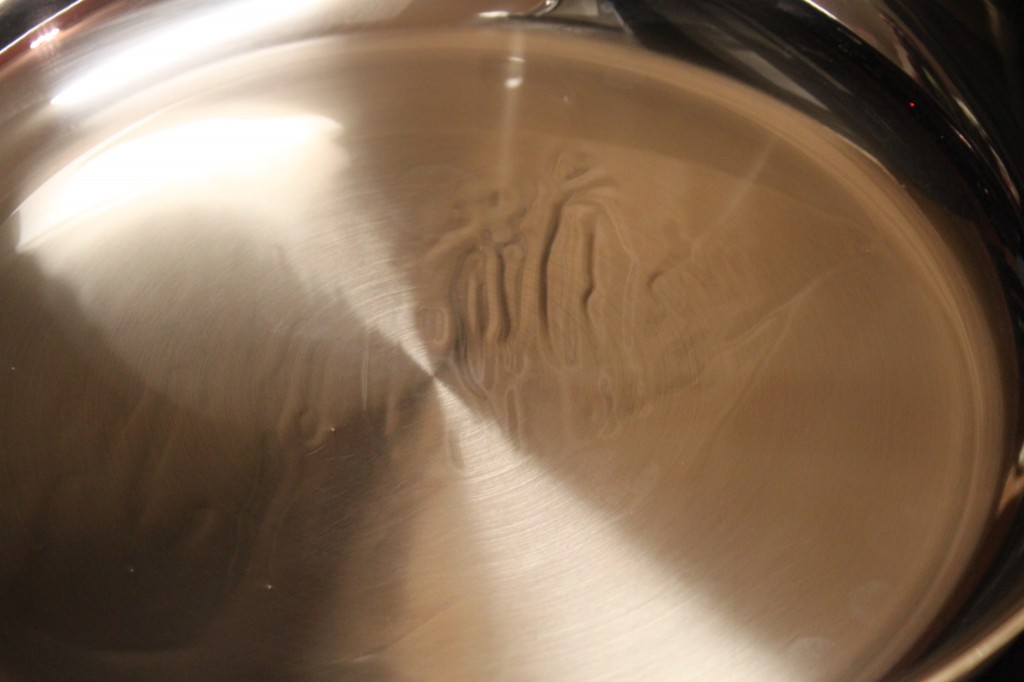
Once you see this it is time to immediately add your food!
I want to go big or go home. So I choose fish instead of chicken for this experiment. I have never been able to cook fish in a stainless steel pan without it sticking.
In they go. After 4 minutes it is time to flip them. My sweaty palms grab the spatula. It is a moment of truth for me:
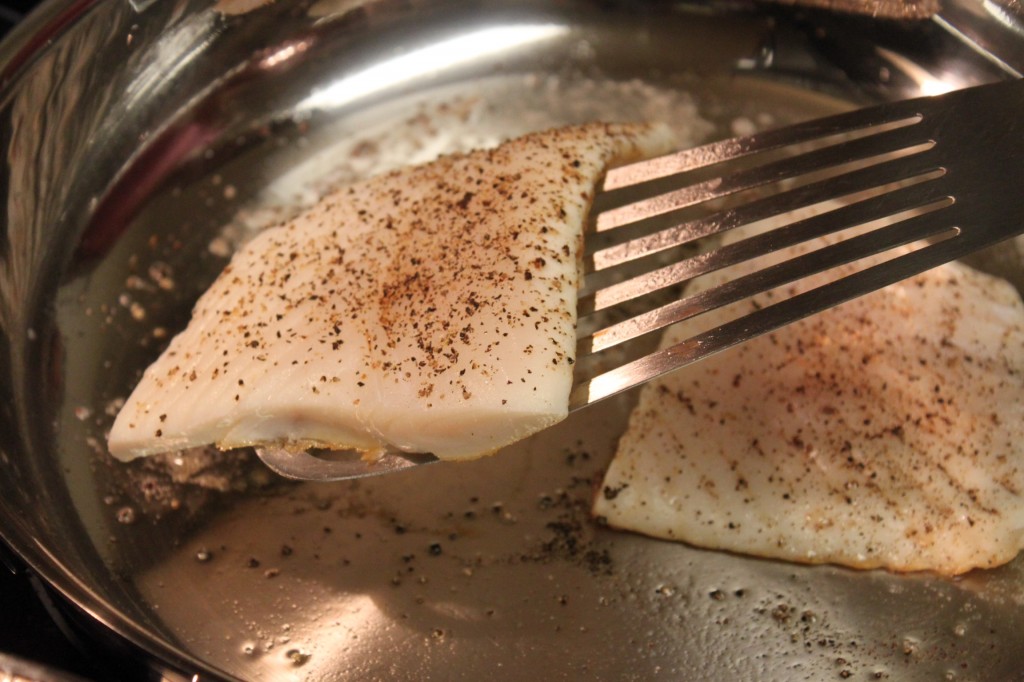
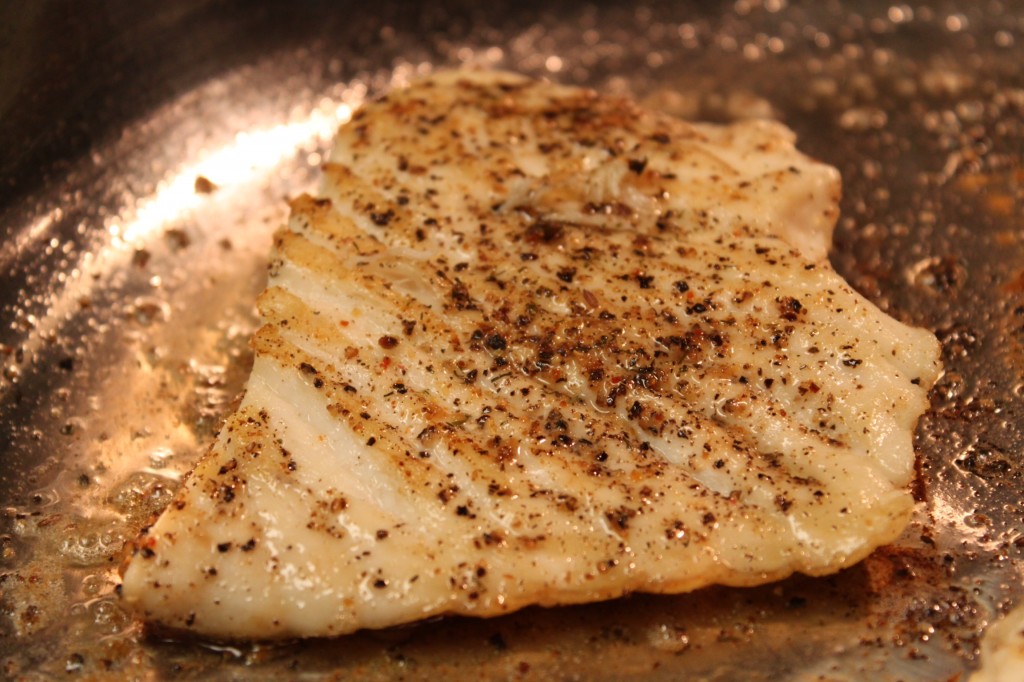
And up she comes. Perfect execution. No fish stuck to my pan!!!
And that is how you properly heat your pan. I have done this water experiment the first several times I used my pan. After repetition you begin to learn the exact time it takes for your pan to heat properly. Then you become a seasoned pro and you do not need the water experiment anymore.
Basically, you’re ready to compete on The Next Iron Chef.
A Note About Stainless Steel Pans
I did not only pick a Tri-Ply stainless steel pan over a non-stick pan because some lady was not confident in my ability to master it. I did it for the following reasons:
- When I thought about the kitchens of my favorite restaurants or my favorite celebrity chefs I recalled that they all used stainless steel pans. There must be a reason…
- I am a huge fan of my meat being all browned perfectly with a gorgeous crust and I have never been able to create that in a non-stick pan.
- I LOVE making reductions. (In cooking, reduction is the process of thickening and intensifying the flavor of a liquid mixture such as a soup or sauce.) In many of the recipes I use, they utilize the little brown bits (also called fonds) leftover in a pan after frying to make a rich sauce. BUT, these beautiful brown bits are not able to be created in a non-stick pan…because nothing can stick.
And that is why I went with stainless steel!
And now, for the cliff notes:

Any questions?!
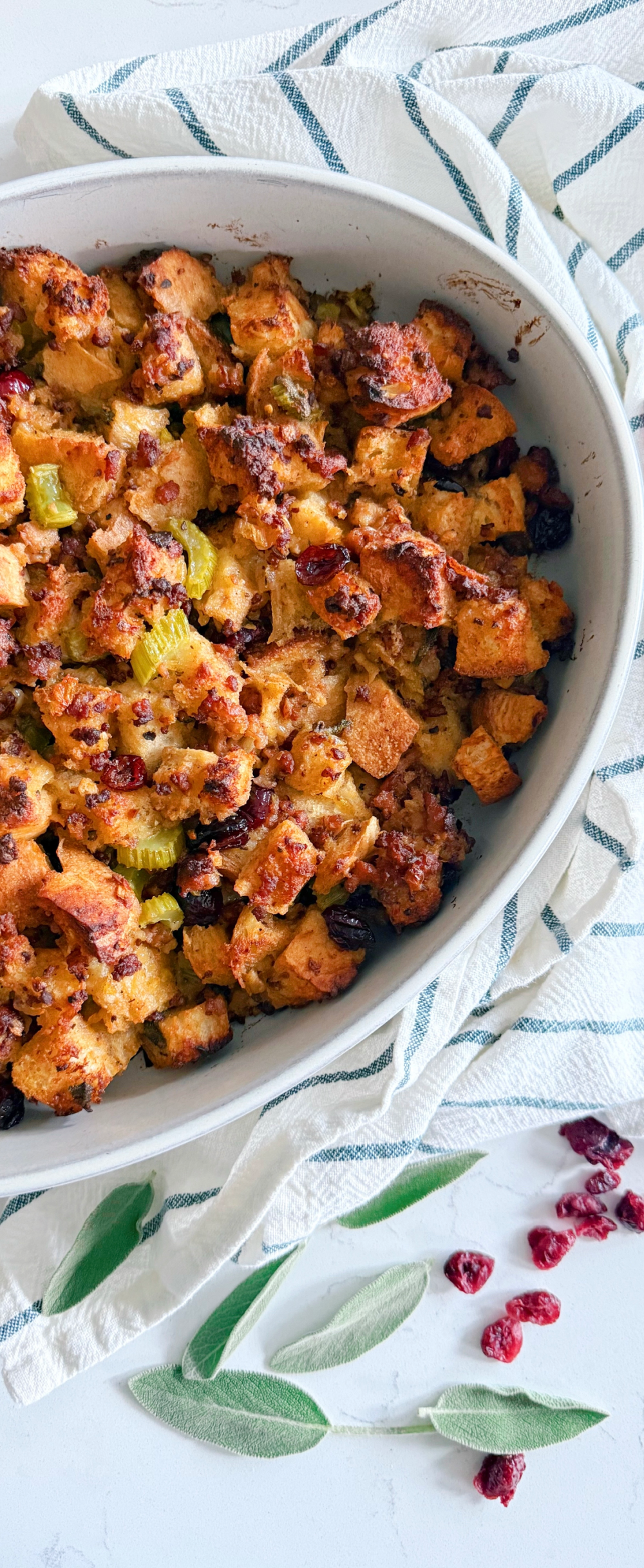
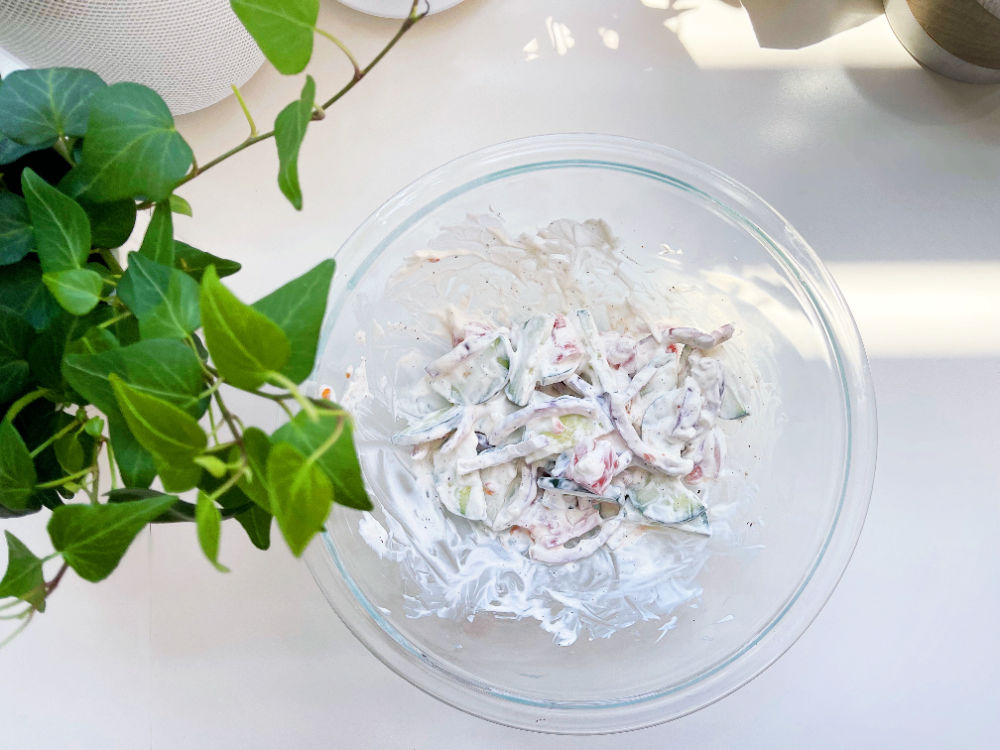
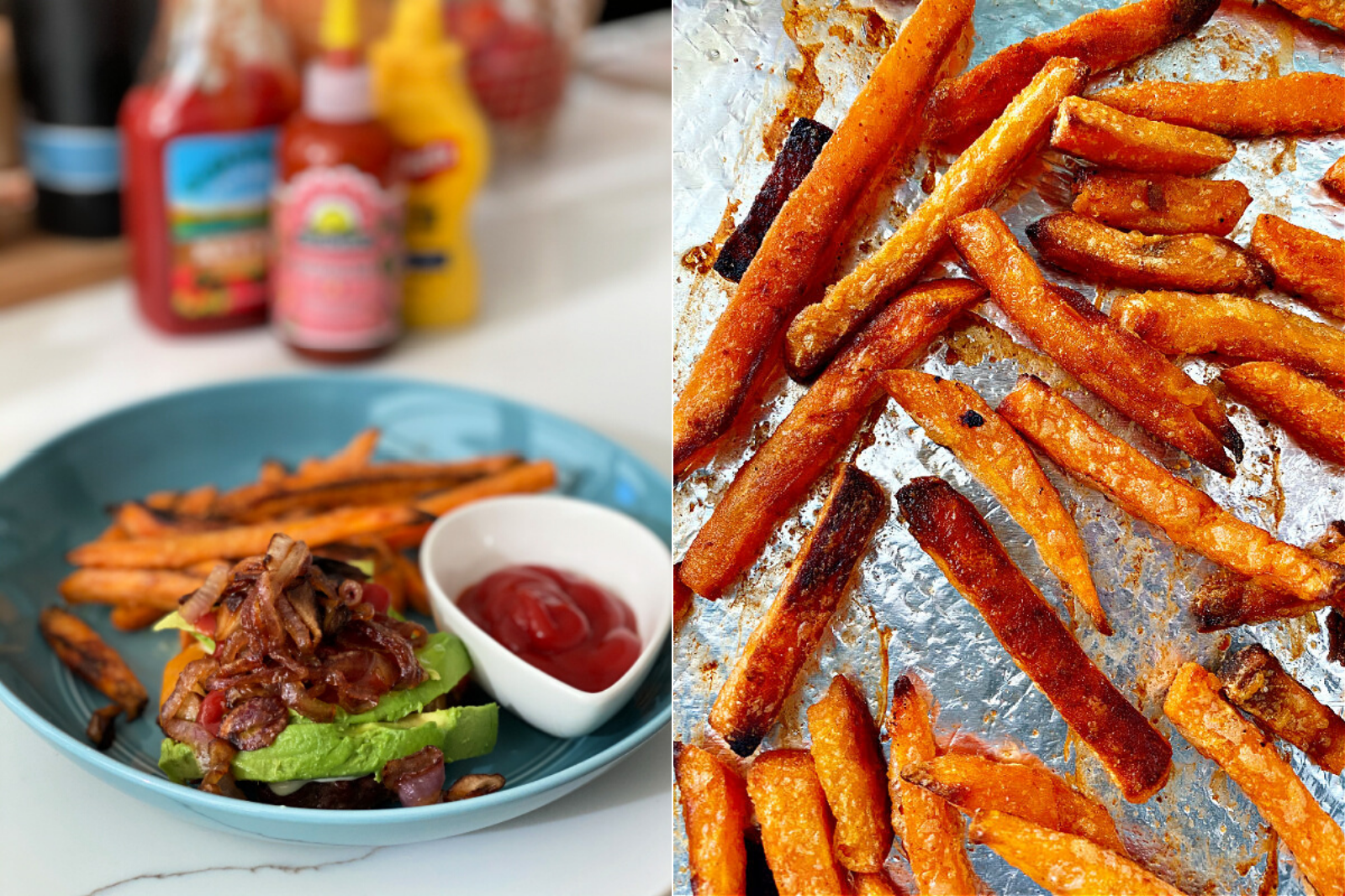
I’m trying to revert back to stainless and this post is very helpful! Stout is absolutely adorable and gave me a big smile. Is he a Yorkie?
I’m trying to revert back to stainless and this post is very helpful! Stout is absolutely adorable and gave me a big smile. Is he a Yorkie?
Thank you for this! I wanted a stainless steel pan like the chefs use for so long and finally sprung for one after ruining yet another inexpensive Teflon pan over time.I was so excited to sear, saute and fond my way into the fall and winter. Then the sausage stuck, the hamburger I just finished making that brought me here to you in a defiant intent not to give up, stuck (it still tasted great) I couldn’t figure it out I had used medium heat like all the advice says. The sausage I made last week had cemented itself almost instantly to the pan. I was so disappointed. Now I can’t wait to try gain! You gave me hope for my shiny new pan and I will let you know how it goes. PS I have a gas stove any additional advice would be appreciated! ~ Jenny
Thank you I am
Going to try this I hope it works because I have read so many things but it still sticks but you have explained it much better to me thank you I like to know what is the best way to get heat grease stains and stains out of your stainless steel pans
Thank you. I am about to go and get my first stainless steel pan, or pot.
Would you recommend for an electric stove? Ceramic top?
You are my hero for the week!
Thank you! I got new cookware and need to keep it safe for healthy eating!
Thank you so much. I’m a keen cook and invested in a SS pan, then worried I’d done a stupid thing. Going to try this tomorrow….xx
Can you lower the heat once the food is in or will that make it stick? If you lower the heat before you put food in will that make it stick?
Not only was this informative it was also laugh out loud funny. You write beautifully. Thank you for helping me determine whether or not to add stainless steel pans to my Amazon wish list!
We can retain more of the essential minerals and vitamins in our meals by cooking in a stainless steel pan without food sticking. When we cook with aluminum or non-stick pans, we lose minerals and vitamins. Overall, the guide was very helpful. Thank you very much!
Thank you for posting this I beleive it will help, that being said I obviously looked up this topic after I couldn’t seem to master the stainless pan. Is there anyway of saving your food after you’ve already begun and it is a hot stuck mess? Thank you
Wonderful. Thank you.
[…] is a secret to cooking with stainless steel that once you know it, it becomes so much easier to cook with and to clean. Here are safe and […]
So once the pan is at the right temp and you put the oil and food in, will changing the temp of the pan (low heat/high heat) cause the food to stick? Do you have to keep the pan at the goldilocks temp at all times to prevent sticking?
How do you maintain temp/breading when doing fish fillets…with this temp. process??
Thank you so much for this! I just got a new SS pan after using non-stick forever. Using your technique on this new pan, my tilapia came out perfect! Topped it off with an avocado lime sauce and the flavor is soooo much better compared to cooking fish on non-stick. Thank you again for putting this helpful technique out there! Cheers!
I was literally about to sell my set of all plaid stainless steel pants. I had not been able to cook one single thing without it sticking. Even in the saucepan. One time I put a can of baked beans in the saucepan and simmered it for a while and like an inch of the baked beans were stuck to the bottom. Thank you for this info
I use stainless steel all the time with no problem. The trick is to leave whatever you’re cooking alone until it moves without sticking, meaning don’t be flipping it multiple times. Don’t have the heat too high and when you can lift it easily, it’s ready to be flipped. Steak is 5 minutes on first side, 5 minutes on second side, take off heat and rest 5 minutes. Perfect every time.
I have a SS fry pan, never enjoyed cooking with it. Thanks for your info I now know what to do. Thanks much
Great article! What oils do you recommend?!
Thank you, bless you. I never knew this. I love cooking with cast iron but it’s quite heavy, hate non stick, love stainless but I have had a great problem with sticking. Problem solved! I always skip to what I’m looking for, but your story started so fun I read it all. I’m glad I did. Your story was really cute and fun.
Thankyou. Loved your story and the way you told it. Clear,yet with some humour…and SUCCESS!
Yes, I’m back to buying an 18/10 or Scanpan or something similar.
Perfect! Thank you so much for this! I had to read this to my husband. We both enjoyed it so much. Made our day and this works! Nothing sticked and my stainless steel pan it’s beautiful.
Thanks again!
Barb & John
I love your wit and the thoroughness of this post. Thank you. I love my cast iron and am looking to try carbon steel. We already have lots of stainless and rarely use it because of food sticking. Thanks for the tips. I’ll try it. I’m wondering if you have success with eggs in stainless.
I inherited my mother’s All Clad pots and pans. I have been in the same hesitation that you described in your article. Thank you for giving me the courage to go back in there and use what they are intended to do- cook marvelous memorable food!
So…I got the pan to the perfect temperature. This is around 200 degrees F. From this point I can add ANY food and cook at this temperature?